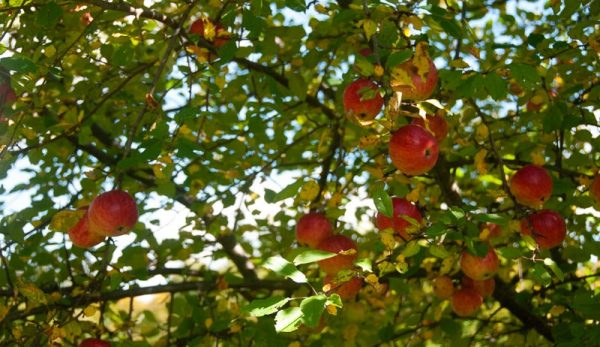
In order to preserve the genetics responsible for beloved apple varieties, apple trees are produced by grafting. This means that scion wood (or even just a bud) from a preferred specimen is grafted to rootstock so that the tree above the graft union is genetically identical to the tree from which the scion wood came.
The scion wood is what makes an apple tree grow into a specific variety. But exactly how the scion wood performs is influenced by the rootstock on which it grows. If you’re interested in grafting apple trees, choosing the right rootstock is a critical step.
Here are four things to consider when buying apple rootstock.
Read more: Check out this new tool for grafting trees!
Dwarfing (or Non-Dwarfing) Tendencies
What size of apple tree would you like to grow? This should be determined before you acquire rootstock, because the rootstock plays a big role in the size of the eventual tree.
Some rootstocks have strong dwarfing tendencies, growing small trees that can be squeezed into tiny lawns and tight spaces. Consider M.27 rootstock, which dwarfs trees down to 6 feet tall or less. Other rootstocks produce semi-dwarf trees, and some have little to no dwarfing tendency.
So what size tree would you like? Are you looking for a dwarf tree that’s easy to pick by hand or with a short apple picker? Or do you want to grow a standard-sized tree that reaches 30 feet tall and produces large crops of apples?
The choice is yours, and it starts with the rootstock.
Cold Tolerance
Rootstock hardiness varies from one type to another. And you don’t want to inadvertently purchase rootstock that isn’t hardy enough to survive your local winters.
Use the USDA Plant Hardiness Zone Map to determine the typical extreme minimum winter temperature for your area. Then shop for rootstock that is sufficiently hardy for your zone. Antonovka rootstock, for example, is considered hardy down to -50 degrees F, which means it can survive all the way into Zone 2 (where the average extreme minimum temperature is -40 to -50 degrees F).
Keep in mind, however, that cold hardiness isn’t just about tolerating extremely cold temperatures. Some rootstocks are better able to handle the temperature swings associated with winters in warmer locales. Putting in the research to find a rootstock proven to succeed in your area is worth the time investment, given the long-term rewards you’ll reap from the resulting trees.
Read more: What do the USDA hardiness zones define? We take a look.
Disease Resistance
Rootstocks can also vary in their resistance to different apple tree diseases. M.9, for example, puts up a good fight against the fungal disease that causes collar rot in poorly drained soils. If you know that apple trees in your area struggle against a certain disease, see if you can find a rootstock that offers some natural resistance.
Soil Preferences
Not all rootstocks relish all types of soil, though some are more adaptable than others. If you have clay-based soil, shop for rootstock that can handle heavy (and possibly damp) soils. If you’re not sure what type of soil you have, conduct some research or have your soil analyzed. You’ll learn a lot and set yourself up for success choosing suitable rootstock.
Planting an orchard is a delightful project, especially when you’re grafting trees perfectly suited for your area and needs. Have fun!




